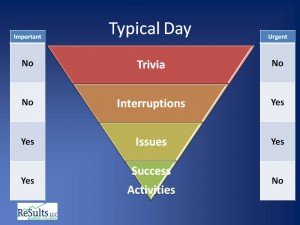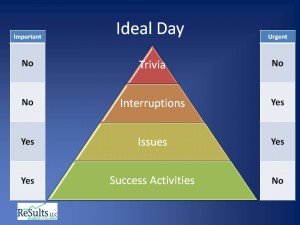Learn the 4 Ds of Time Management
The real secret to leadership starts by improving time management skills.
No one can manage time; it exists and just keeps marching forward.
What can be managed is what you do with your time.
One of the best books on managing yourself to get the most out of your business is Stephen Covey’s The 7 Habits of HIGHLY EFFECTIVE PEOPLE. In this book, Mr. Covey introduces the idea of time quadrants, which break into things that are either urgent or not urgent and things that are either important or not important.
To illustrate this concept further, I have developed the following time pyramid:
Most people allow things that are not important and not urgent to fill their days. These are activities like reading countless emails while reading the emails; decide to check their stocks, while checking stocks, decide to see what’s happening in the news, and so forth. Before they know it, 30 minutes of valuable time has gone by. This may not be your trivia, but we all have trivia that can consume our day.

The next thing that consumes our day is interruptions. These are those unimportant things that come up that are urgent. Things like the copier getting jammed the person who comes in and asks you the same question to the same problem for the 20th time, etc. Interruptions generally mean a lack of systems and training in your business.
The next areas that consume time are the issues. These are the things that are both urgent and important. Often, we refer to these issues as fires. Issues are things like: shipping problems; customer complaints; urgent quotes and employee problems. Issues are generally things that could have been avoided with a little planning. The problem is that most people fill their day with trivia, interruptions, and issues so that they never have time for success activities.
Success activities are those things that will truly build your business. They are activities that are extremely important, but not urgent. Success activities include; business planning, forecasting, team building, employee evaluations, marketing, sales calls, and any other activity that will help your business run better, earn more and be a better place to work.
Truly successful business people have learned to jealously protect their time. They know that time is their most important asset. Someone once told me that you can make and lose a million dollars and have the chance to make it again, but once you waste a minute, it is gone forever.
To be successful, you need to flip the pyramid over. To do this, start filling in your week with success activities. You can accomplish this by scheduling an appointment with yourself and then keeping that appointment. Next, work on the issues that come up. As you spend more time on success activities, you will experience fewer issues. In addition, as you spend more time on successful activities by building systems and team training, you will experience fewer interruptions. Eliminating trivia altogether will be very difficult. The idea is to minimize trivia to a point where these activities only fill in around your success activities and issues.
Learning to protect your time will significantly improve your ability to focus on the truly important activities that will grow your business.
In The Power of Focus, Jack Canfield, Mark Victor Hansen, and Les Hewitt describe a process to “separate so-called urgent tasks from your most important priorities.” These authors suggest that you hold the power to control your time. The four “Ds” hold the key to your control.
- Do it now. This is how most of us manage our time. Reactive. If the phone rings you answer it. If you get an email or text you respond to it. You should only do it now if: 1) it will take longer to delegate the task then it will to do it or 2) it is an issue that must be addressed urgently.
- Dump it. We all employ this action when we read our mail. We dump the junk mail. The same is true with tasks. With every item that comes your way, you have the option of saying, “I choose not to do this.” That’s why it is important for every individual and organization to have clearly defined its purpose, guiding principles, vision, and mission. See my blog on the 4 Steps to know where you are going. When you know clearly why you exist (what you do to serve your defined clientele), you can be firm in saying “No!”
- Delegate it. One of the greatest gifts that I have given to my coaching clients is the ability to delegate. There is a big difference between delegation and abdication. Delegation is a management process where you assign a task, gain commitment from the person accepting the task, check for understanding, and manage the progress along the way. The proper delegation will free up a significant amount of time and who knows, maybe the task will be done better by someone with more specific knowledge.
- Defer it. Be careful with this category. This is not an indefinite holding place for things you don’t want to do. Rather, it is a place for tasks that will be completed at a specific date in the future. You need to make sure that you have s system to bring the task out and start working on it.
Gaining control of the “Four D’s of Time Management” will give you both focus and balance in your business and your life. Both items will help to make you a successful leader.

